A Non-Invasive In Situ Spectroscopic Analysis of Cinnabar Minerals to Assist Provenance Studies of Archaeological Pigments
Abstract
1. Introduction
2. Materials and Methods
2.1. Samples
2.2. Instruments and Analytical Approach
3. Results and Discussion
3.1. Mineralogical Characterization of the Cinnabar Ores from the Almadén Mining District
3.2. Mineralogical Characterization of the Raw Cinnabar Pigment of the Archaeological Park of Pompeii
3.3. Identification of Compositional Similarities and Differences among the Cinnabar Mineral Samples and the Pompeian Cinnabar Pigment through EDXRF Spectroscopy
4. Conclusions
Author Contributions
Funding
Data Availability Statement
Acknowledgments
Conflicts of Interest
References
- Martín-Gil, J.; Martín-Gil, F.J.; Delibes-de-Castro, G.; Zapatero-Magdaleno, P.; Sarabia-Herrero, F.J. The First Known Use of Vermillion. Experientia 1995, 51, 759–761. [Google Scholar] [CrossRef] [PubMed]
- Cinnabar, the Ancient Pigment of Mercury. Available online: https://www.thoughtco.com/cinnabar-the-ancient-pigment-of-mercury-170556 (accessed on 19 December 2019).
- Tsantini, E.; Minami, T.; Takahashi, K.; Ontiveros, M.Á.C. Analysis of Sulphur Isotopes to Identify the Origin of Cinnabar in the Roman Wall Paintings from Badalona (Spain). J. Archaeol. Sci. Rep. 2018, 18, 300–307. [Google Scholar] [CrossRef]
- Gettens, R.J.; Feller, R.L.; Chase, W.T. Vermilion and Cinnabar. Stud. Conserv. 1972, 17, 45–69. [Google Scholar] [CrossRef]
- Le Fur, D. Les Pigments Dans La Peinture Égyptienne. In Pigments et Colorants de l’Antiquité et du Moyen Âge: Teinture, peinture, enluminure, études historiques et physico-chimiques; CNRS Éditions: Paris, France, 1990; pp. 181–188. [Google Scholar]
- Harris, C.D. Cinnabar: The Symbolic, Seductive, Sublethal Shade of Pompeii; Brandeis University: Waltham, MA, USA, 2015. [Google Scholar]
- Trinquier, J. Cinnabaris et « Sang-Dragon »: Le « Cinabre » Des Anciens Entre Minéral, Végétal et Animal. Rev. Archéol. 2013, 56, 305–346. [Google Scholar] [CrossRef]
- Sharples, R.W. Theophrastus of Eresus: Life, Writings, Various Reports, Logic, Physics, Metaphysics, Theology, Mathematics; Brill: Leiden, The Netherlands, 1998. [Google Scholar]
- The Natural History of Pliny; Henry George Bohn: London, UK, 1855.
- Nöller, R. Cinnabar Reviewed: Characterization of the Red Pigment and Its Reactions. Stud. Conserv. 2015, 60, 79–87. [Google Scholar] [CrossRef]
- Spangenberg, J.E.; Lavrič, J.V.; Meisser, N.; Serneels, V. Sulfur Isotope Analysis of Cinnabar from Roman Wall Paintings by Elemental Analysis/Isotope Ratio Mass Spectrometry—Tracking the Origin of Archaeological Red Pigments and Their Authenticity. Rapid Commun. Mass. Spectrom. 2010, 24, 2812–2816. [Google Scholar] [CrossRef]
- Vitruvius. The Architecture of Marcus Vitruvius Pollio. In Ten Books; Priestley and Weale: London, UK, 1826. [Google Scholar]
- Hernández, A.; Jébrak, M.; Higueras, P.; Oyarzun, R.; Morata, D.; Munhá, J. The Almadén Mercury Mining District, Spain. Miner. Deposita 1999, 34, 539–548. [Google Scholar] [CrossRef]
- Gray, J.E.; Pribil, M.J.; Higueras, P.L. Mercury Isotope Fractionation during Ore Retorting in the Almadén Mining District, Spain. Chem. Geol. 2013, 357, 150–157. [Google Scholar] [CrossRef]
- Eastaugh, N.; Walsh, V.; Chaplin, T.; Siddall, R. Pigment Compendium—A Dictionary and Optical Microscopy of Historical Pigments; Routledge: Oxford, UK, 2008. [Google Scholar]
- Miguel, C.; Pinto, J.V.; Clarke, M.; Melo, M.J. The Alchemy of Red Mercury Sulphide: The Production of Vermilion for Medieval Art. Dyes. Pigm. 2014, 102, 210–217. [Google Scholar] [CrossRef]
- Elert, K.; Cardell, C. Weathering Behavior of Cinnabar-Based Tempera Paints upon Natural and Accelerated Aging. Spectrochim. Acta. A. Mol. Biomol. Spectrosc. 2019, 216, 236–248. [Google Scholar] [CrossRef]
- Higueras, P.; Munhá, J.; Oyarzun, R.; Tassinari, C.C.G.; Ruiz, I.R. First Lead Isotopic Data for Cinnabar in the Almadén District (Spain): Implications for the Genesis of the Mercury Deposits. Miner. Deposita 2005, 40, 115–122. [Google Scholar] [CrossRef]
- Mazzocchin, G.A.; Baraldi, P.; Barbante, C. Isotopic Analysis of Lead Present in the Cinnabar of Roman Wall Paintings from the Xth Regio “(Venetia et Histria)” by ICP-MS. Talanta 2008, 74, 690–693. [Google Scholar] [CrossRef] [PubMed]
- Marcaida, I.; Maguregui, M.; Morillas, H.; García-Florentino, C.; Knuutinen, U.; Carrero, J.A.; Fdez-Ortiz de Vallejuelo, S.; Pitarch Martí, A.; Castro, K.; Madariaga, J.M. Multispectroscopic and Isotopic Ratio Analysis To Characterize the Inorganic Binder Used on Pompeian Pink and Purple Lake Pigments. Anal. Chem. 2016, 88, 6395–6402. [Google Scholar] [CrossRef]
- Trentin, S. Reality, Artifice and Changing Landscapes in the House of Marcus Lucretius in Pompeii. Greece Rome 2019, 66, 71–92. [Google Scholar] [CrossRef]
- Seiler, F.; Grunwald, P.; Gut, W.; Diederichs, H.; Sellers, J. Casa Degli Amorini Dorati (VI 16, 7, 38); Häuser in Pompeji: Hirmer, München, 1992; ISBN 978-3-7774-5450-4. [Google Scholar]
- Database of Raman Spectroscopy, X-ray Diffraction and Chemistry of Minerals. Available online: https://rruff.info/ (accessed on 26 December 2022).
- Nusimovici, M.A.; Meskaoui, A. Raman Scattering by α-HgS (Cinnabar). Phys. Status Solidi B 1973, 58, 121–125. [Google Scholar] [CrossRef]
- Yadav, A.K.; Singh, P. A Review of the Structures of Oxide Glasses by Raman Spectroscopy. RSC Adv. 2015, 5, 67583–67609. [Google Scholar] [CrossRef]
- Ohsaka, T.; Izumi, F.; Fujiki, Y. Raman Spectrum of Anatase, TiO2. J. Raman Spectrosc. 1978, 7, 321–324. [Google Scholar] [CrossRef]
- Murad, E. Identification of Minor Amounts of Anatase in Kaolins by Raman Spectroscopy. Am. Mineral. 1997, 82, 203–206. [Google Scholar] [CrossRef]
- Krishnan, R.S. Raman Spectrum of Quartz. Nature 1945, 155, 452. [Google Scholar] [CrossRef]
- Mernagh, T.P.; Trudu, A.G. A Laser Raman Microprobe Study of Some Geologically Important Sulphide Minerals. Chem. Geol. 1993, 103, 113–127. [Google Scholar] [CrossRef]
- Jébrak, M.; Higueras, P.L.; Marcoux, É.; Lorenzo, S. Geology and Geochemistry of High-Grade, Volcanic Rock-Hosted, Mercury Mineralisation in the Nuevo Entredicho Deposit, Almadén District, Spain. Miner. Deposita 2002, 37, 421–432. [Google Scholar] [CrossRef]
- Saupé, F.; Arnold, M. Sulphur Isotope Geochemistry of the Ores and Country Rocks at the Almadén Mercury Deposit, Ciudad Real, Spain. Geochim. Cosmochim. Acta 1992, 56, 3765–3780. [Google Scholar] [CrossRef]
- Luque, L.D.M.; Ruiz, J.R. Análisis de pigmentos por espectroscopia Raman de la “villa” romana de El Ruedo (Almedinilla, Córdoba). Antiquitas 2015, 27, 69–85. [Google Scholar]
- Marcaida, I.; Maguregui, M.; Morillas, H.; Veneranda, M.; Prieto-Taboada, N.; Fdez-Ortiz de Vallejuelo, S.; Madariaga, J.M. Raman Microscopy as a Tool to Discriminate Mineral Phases of Volcanic Origin and Contaminations on Red and Yellow Ochre Raw Pigments from Pompeii. J. Raman Spectrosc. 2019, 50, 143–149. [Google Scholar] [CrossRef]
- Balassone, G.; Petti, C.; Mondillo, N.; Panikorovskii, T.L.; de Gennaro, R.; Cappelletti, P.; Altomare, A.; Corriero, N.; Cangiano, M.; D’Orazio, L. Copper Minerals at Vesuvius Volcano (Southern Italy): A Mineralogical Review. Minerals 2019, 9, 730. [Google Scholar] [CrossRef]
- Hunt-Ortiz, M.A.; Consuegra-Rodríguez, S.; Díaz del Río-Español, P.; Hurtado-Pérez, V.M.; Montero-Ruiz, I. Neolithic and Chalcolithic –VI to III Millennia BC—Use of Cinnabar (HgS) in the Iberian Peninsula: Analytical Identification and Lead Isotope Data for an Early Mineral Exploitation of the Almadén (Ciudad Real, Spain) Mining District. In Proceedings of the History of Research in Mineral Resources, Madrid, Spain, 1–14 July 2010; Instituto Geológico y Minero de España: Madrid, Spain; Volume 13, pp. 3–13. [Google Scholar]
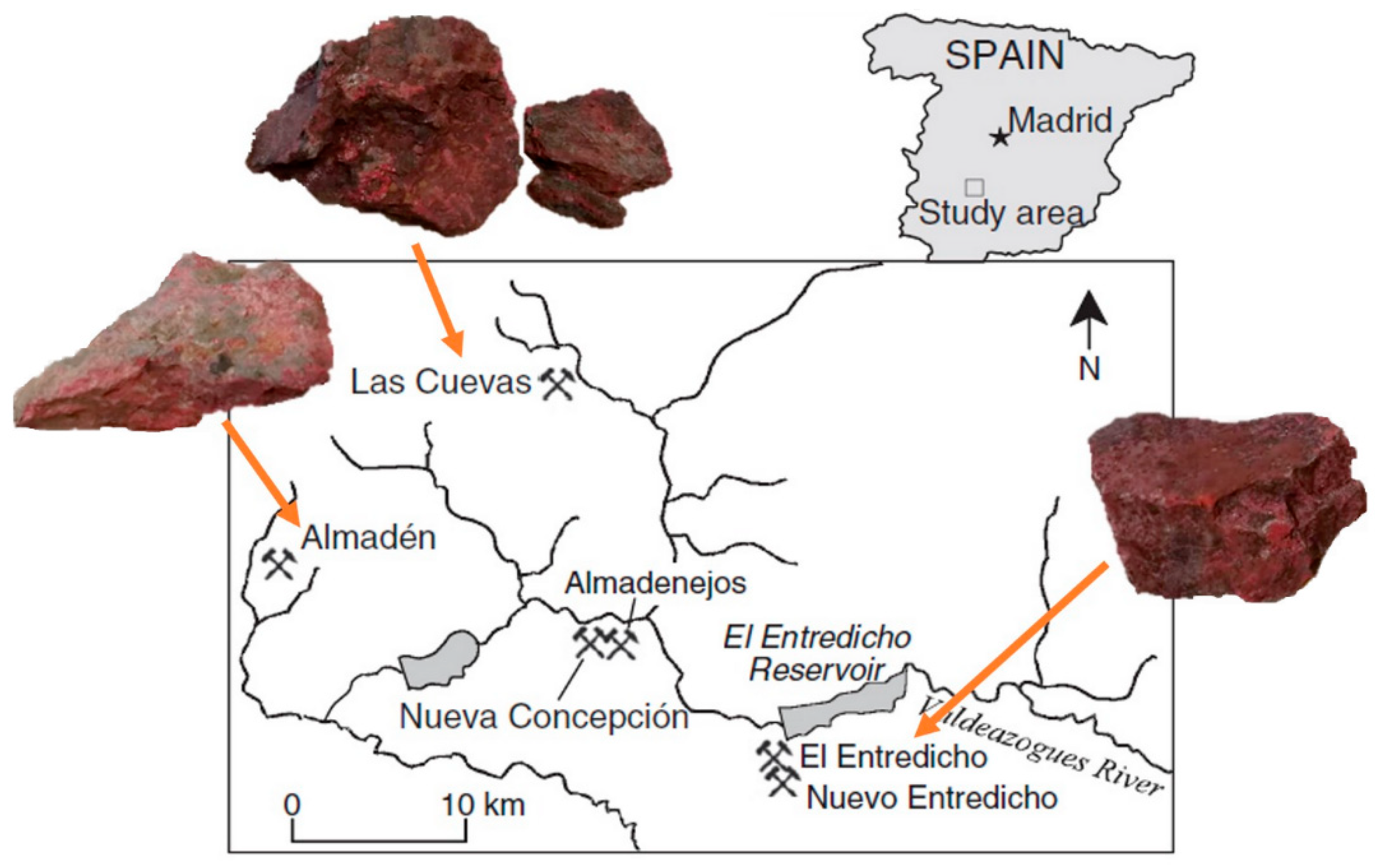
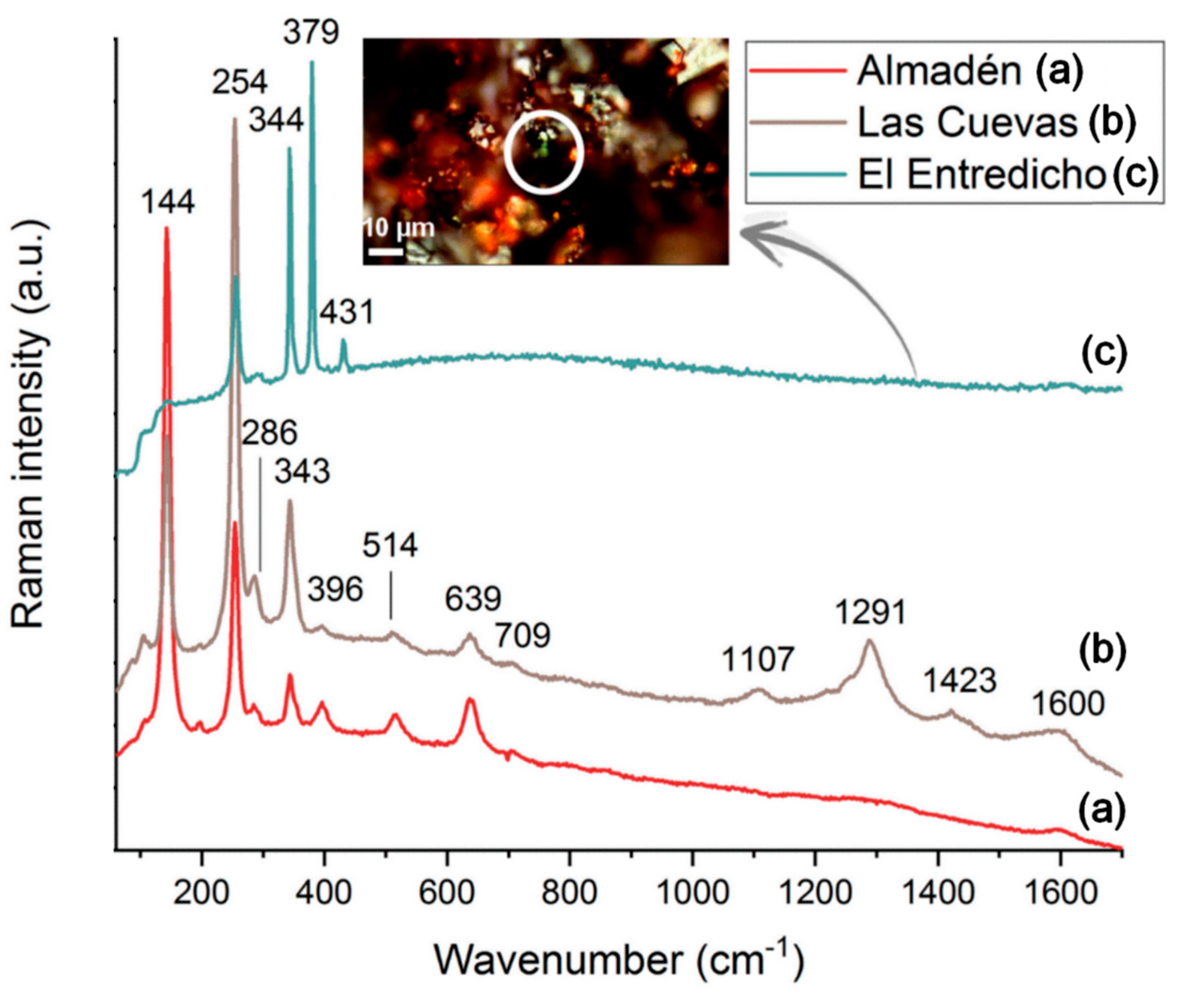
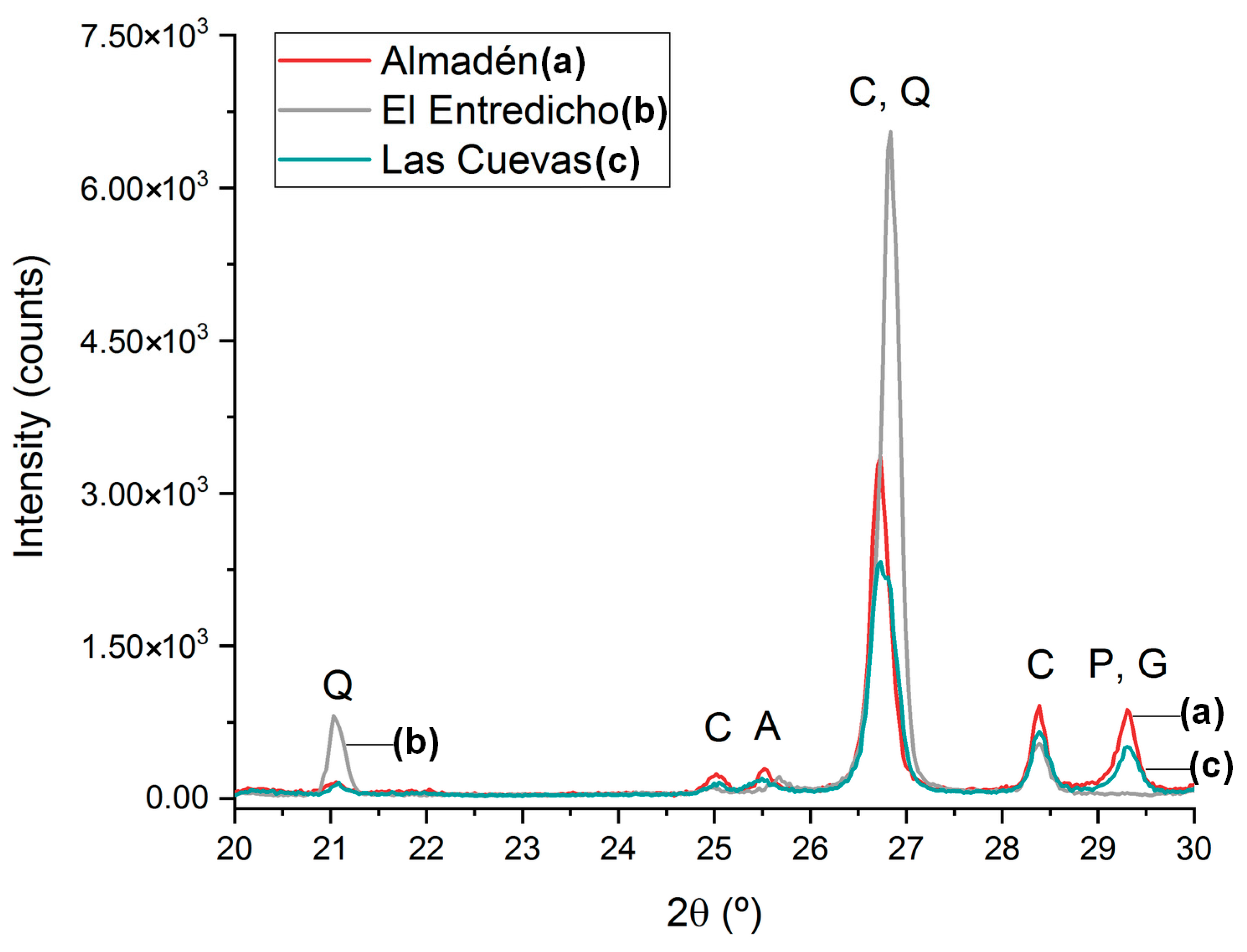

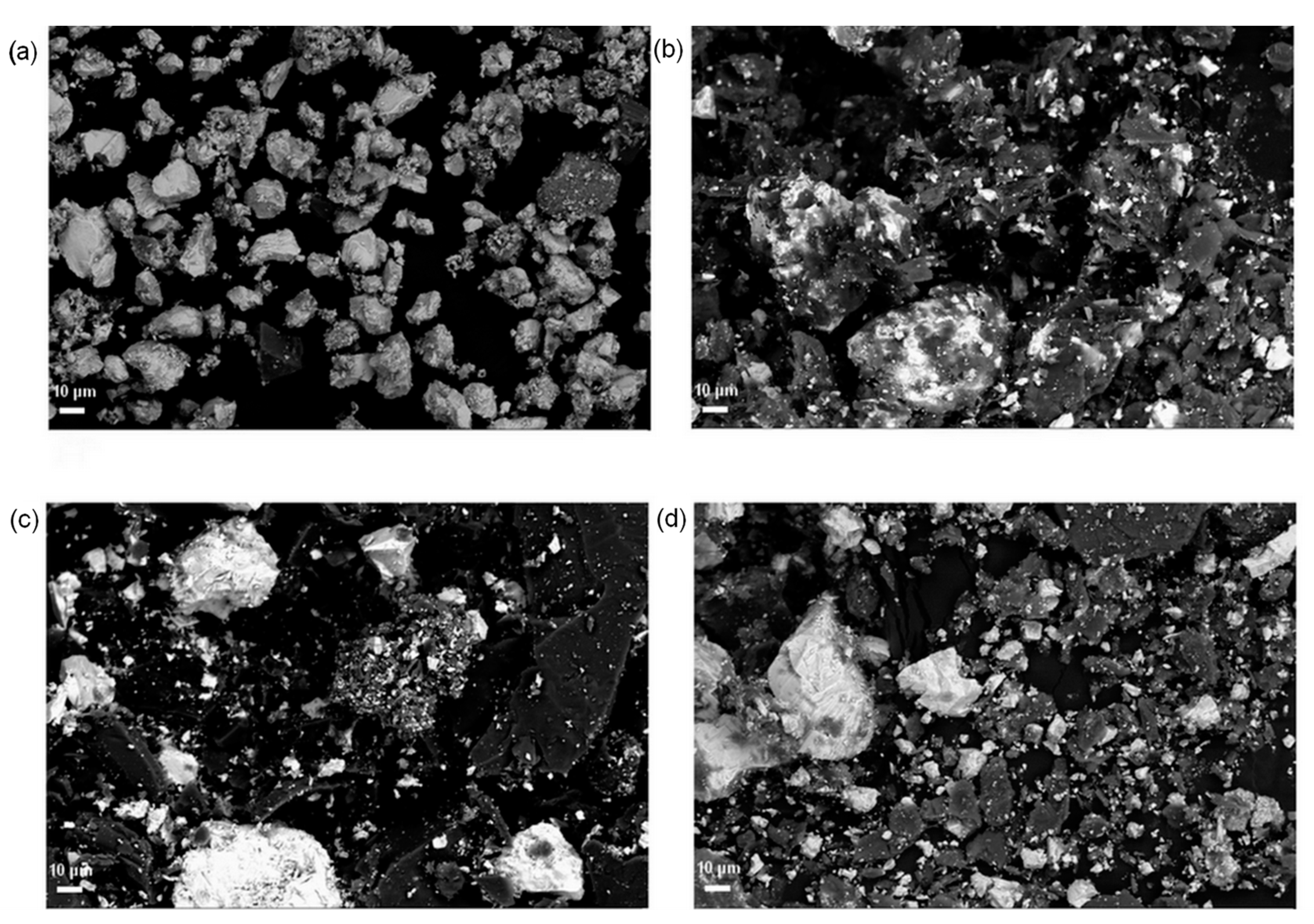

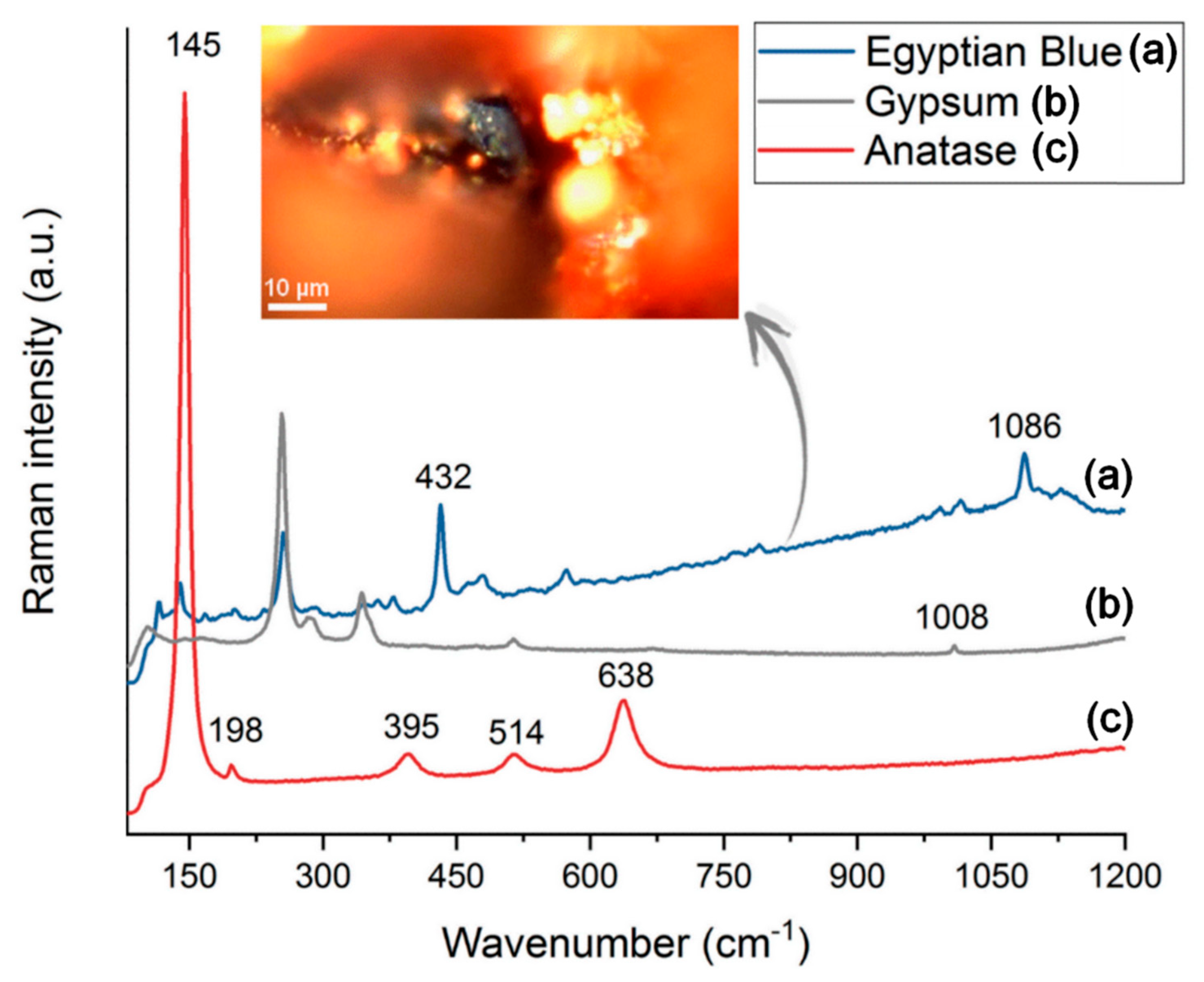
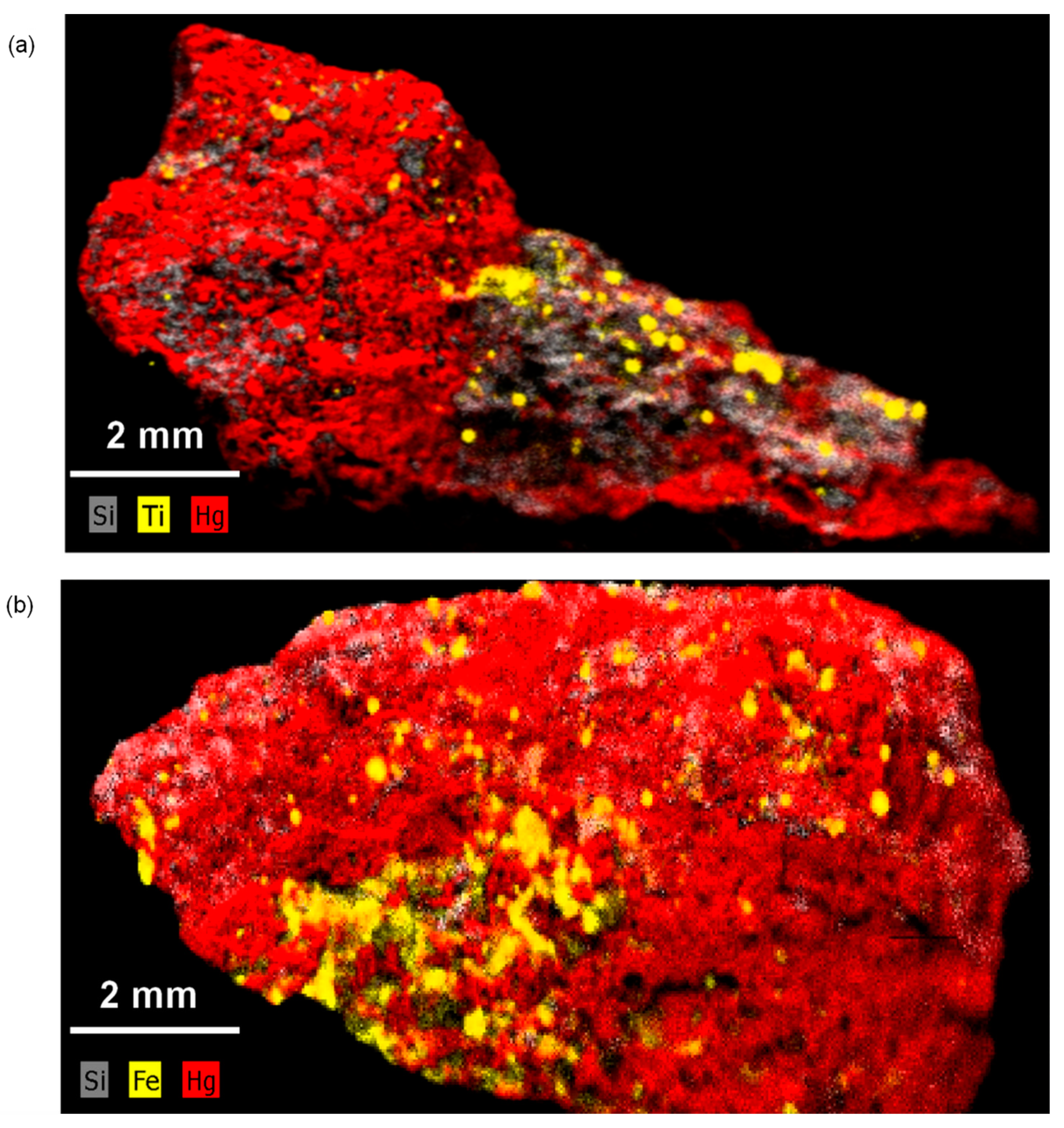

| Type of Sample | Almadén | El Entredicho | Las Cuevas |
|---|---|---|---|
| Ore fragment | 69 (w), 105 (m), 143 (s), 197 (w), 254 (vs), 287 (m), 344 (s), 397 (m), 516 (m), 638 (m), 702 (vw), 1602 (vw), 2069 (vw) | 63 (w), 86 (w), 105 (w), 127 (w), 144 (w), 175 (m), 255 (vs), 288 (m), 344 (s), 379 (w), 436 (w), 465 (m), 724 (w), 1096 (s), 1318 (m), 1601 (m) | 87 (w), 105 (m), 144 (s), 195 (w), 254 (vs), 287 (m), 344 (s), 394 (m), 513 (m), 638 (m), 709 (vw), 1107 (vw), 1311 (m), 1423 (m), 1601 (m) |
| Scraped powder | 85 (m), 105 (m), 144 (w), 253 (vs), 286 (m), 343 (s) | 85 (m), 104 (m), 144 (w), 253 (vs), 286 (m), 343 (s) | 84 (m), 104 (m), 144 (w), 253 (vs), 286 (m), 343 (s), 580 (w), 1027 (w), 1187 (w) |
| Type of Sample | Almadén | El Entredicho | Las Cuevas |
|---|---|---|---|
| Ore fragment | 103 (m), 129 (w), 144 (s), 197 (w), 255 (vs), 287 (m), 344 (s), 397 (m), 465 (m), 516 (m), 639 (m), 1085 (w) | 104 (m), 129 (w), 144 (w), 255 (vs), 284 (m), 344 (s), 379 (m), 431 (m), 465 (m) | 104 (m), 129 (w), 144 (s), 170 (w), 196 (w), 255 (vs), 287 (m), 344 (s), 465 (m), 578 (w), 637 (m), 707 (w), 1175 (w) |
Disclaimer/Publisher’s Note: The statements, opinions and data contained in all publications are solely those of the individual author(s) and contributor(s) and not of MDPI and/or the editor(s). MDPI and/or the editor(s) disclaim responsibility for any injury to people or property resulting from any ideas, methods, instructions or products referred to in the content. |
© 2023 by the authors. Licensee MDPI, Basel, Switzerland. This article is an open access article distributed under the terms and conditions of the Creative Commons Attribution (CC BY) license (https://creativecommons.org/licenses/by/4.0/).
Share and Cite
Pérez-Diez, S.; Bernier, C.; Iñañez, J.G.; Maguregui, M. A Non-Invasive In Situ Spectroscopic Analysis of Cinnabar Minerals to Assist Provenance Studies of Archaeological Pigments. Crystals 2023, 13, 207. https://doi.org/10.3390/cryst13020207
Pérez-Diez S, Bernier C, Iñañez JG, Maguregui M. A Non-Invasive In Situ Spectroscopic Analysis of Cinnabar Minerals to Assist Provenance Studies of Archaeological Pigments. Crystals. 2023; 13(2):207. https://doi.org/10.3390/cryst13020207
Chicago/Turabian StylePérez-Diez, Silvia, Cheyenne Bernier, Javier G. Iñañez, and Maite Maguregui. 2023. "A Non-Invasive In Situ Spectroscopic Analysis of Cinnabar Minerals to Assist Provenance Studies of Archaeological Pigments" Crystals 13, no. 2: 207. https://doi.org/10.3390/cryst13020207
APA StylePérez-Diez, S., Bernier, C., Iñañez, J. G., & Maguregui, M. (2023). A Non-Invasive In Situ Spectroscopic Analysis of Cinnabar Minerals to Assist Provenance Studies of Archaeological Pigments. Crystals, 13(2), 207. https://doi.org/10.3390/cryst13020207







